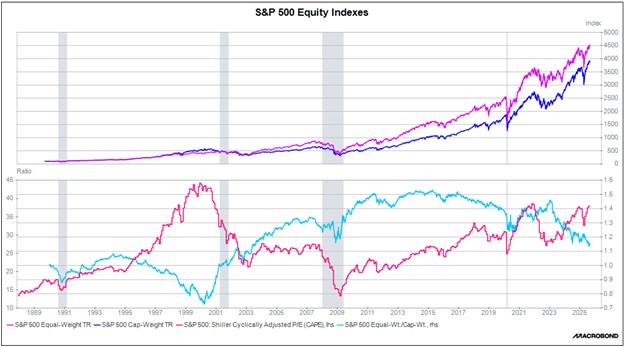by Patrick Fearon-Hernandez, CFA, and Thomas Wash
[Posted: 9:30 AM ET] | PDF
Our Comment begins by examining the White House’s push for a greater share of university patent revenue and the underlying ideological shift this move represents. We then analyze the latest Producer Price Index report and its implications for monetary policy. The discussion will also cover Mexico’s new tariffs on goods from China and other Asian countries, as well as French President Macron’s choice for a new prime minister. We also include a summary of key global economic and domestic data releases.
Industrial Policy: The White House is arguing that it is entitled to a share of the revenue that universities generate from patents developed through federally funded research. During an interview with Axios, Commerce Secretary Howard Lutnick stated that the government should recoup its investment and “participate” in the returns, noting that many universities profit by licensing this research to companies that provided no initial funding. Secretary Lutnick also suggested that this revenue could be used to support Social Security and other public programs.
- This move is consistent with a broader pattern of recent economic policies, such as mandating revenue-sharing from chip sales to China, acquiring a direct stake in Intel, and securing a “golden share” in US Steel (a veto power over key decisions) as a condition for approving its acquisition by Nippon Steel.
- The government’s move to seek payments from companies and organizations appears to be a significant ideological shift away from the “Washington Consensus,” which favored a light-touch approach. This new direction may reflect a preference for state-aligned monopolies that can serve a dual purpose: coordinating policy efforts and generating government revenue.
- This change will likely favor larger companies over smaller ones. Their significant economies of scale give them the financial strength to absorb increased costs that would be a challenge for smaller competitors. Large technology and manufacturing firms are well-positioned to benefit, given their ability to provide solutions for both consumer and military markets. We are entering an era where collaboration between companies and governments is becoming essential for addressing complex challenges.
PPI: Producer prices experienced an unexpected decline in August, signaling that firms are encountering resistance to price increases. The headline Producer Price Index (PPI) reversed from a 0.7% gain in July to a 0.1% decline the following month. Core PPI, which excludes food and energy prices, also fell by 0.1%. A sharp slowdown in trade services was the primary driver behind the decline in overall price pressures. In fact, when excluding trade services, core PPI rose by 0.3%.
- The trade services component of PPI, a key measure of wholesale and retail margins, is essential for monitoring how tariffs are being absorbed by the economy. The index recorded its sharpest one-month decline since July, indicating that businesses are either accepting lower profits or are being forced to reduce prices amid weakening demand.
- This decline, particularly in trade services, can also be a sign that the effects of previous tariff-driven inflation are beginning to wane as businesses and supply chains adapt to the new pricing environment. The contraction in wholesale margins serves as a reliable forward-looking indicator for consumer prices.
- A weak PPI report suggests that companies are struggling to pass tariff costs on to consumers, which may have implications for profit margins. This development bolsters expectations for a Fed rate cut at the upcoming meeting next week. If price pressures continue to abate, we anticipate the Fed will shift its focus away from fighting inflation toward protecting the labor market.
Miran’s Confirmation: The Senate Banking Committee advanced Stephen Miran’s nomination on Wednesday, paving the way for him to participate in the next Federal Open Market Committee (FOMC) meeting. To meet this timeline, the full Senate must confirm his nomination by Monday. If confirmed before the FOMC begins its two-day meeting on Tuesday, Miran is expected to push for a rate cut, likely an aggressive one, probably 50 bps or more.
Mexico Plans Tariffs: The Mexican government has announced a tariff increase of up to 50% on imports from China and other Asian nations. This protectionist measure is a strategic move to safeguard domestic industries ahead of upcoming talks for the North America Free Trade Agreement (now known as USMCA). Since the US is expected to push for a more unified trade policy among the North American bloc, this action by Mexico signals its willingness to align with US concerns about Chinese imports, a point we highlighted in last year’s outlook.
Poland Seeks Assistance: On Wednesday, Poland requested more allied air defense systems and counter-drone technology to protect against new incursions from Russia. The request follows 19 instances where Russian drones crossed into Polish territory and were subsequently shot down by Polish forces. While the conflict did not escalate, this marks the first direct military engagement between NATO and Russian forces since the war in Ukraine began. Although full-scale war is unlikely, the risk of escalation is now elevated.
Political Violence: Popular conservative activist and influencer Charlie Kirk was assassinated during a speaking event at Utah Valley University. The attack underscores the dangerously growing polarization in US politics. An increasingly hostile political environment is likely to fuel further civil unrest, with direct market effects including eroding trust in public institutions. This trend could trigger significant market volatility if investors begin to fear a fundamental weakening of the nation’s political stability.
New French PM: French President Emmanuel Macron has appointed Sébastien Lecornu as the new prime minister. The two share a close relationship, with Macron previously relying on him to negotiate delicate situations, such as the release of hostages held by Hamas. Lecornu maintains connections across the political spectrum, and it is hoped that he will leverage this to finally pass a budget. Nevertheless, France’s complicated political situation continues to fuel uncertainty in the bond market.






